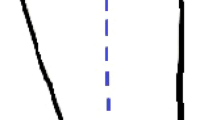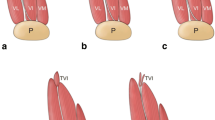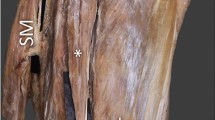Abstract
Purpose
The quadriceps femoris has been described as a muscle composed by four heads: rectus femoris, vastus lateralis, vastus medialis and vastus intermedius. Each head fuse with the other ones making up the quadriceps tendon, which inserts into the patella. Nevertheless, there has been described a fifth component of the quadriceps muscle in recent anatomical publications. Understanding this fifth head may be important for orthopedics and radiologist.
Methods
Cadaveric dissection of left thigh of a female 83 years old was performed to demonstrate a fifth head of the quadriceps femoris muscle.
Results
In this study, a fifth head of the quadriceps femoris muscle was found in the left thigh of a female cadaver 83 years old. This fifth head was made up by four independent muscular fascicles attaching in a common flat tendon that joins distally with the lateral border of the quadriceps tendon. The fifth head found was supplied by branches of the ascending branch of the lateral femoral circumflex artery and by branches of the deep lateral division of the femoral nerve.
Conclusions
The incidence of this fifth belly in cadaveric studies has been reported as a range from 29 to 100%. However, no published articles refer an anatomical finding such as this multi-bellied fifth head. The knowledge of the existence and location of the fifth belly is necessary to make accurate diagnosis of QF muscle strains. Its anatomical course may be involved in patellar tracking.


Similar content being viewed by others
References
Bardeen CR (1907) Develoment and variation of the nerves and the musculature of the inferior extremity and the neighboring regions of the trunk in man. Am J Anat 6:23–56
Golland JA, Mahon M (1986) Anatomical variations in human quadriceps femoris muscles. J Anat 146:263–264
Grob K, Ackland T, Kuster MS, Manestar M, Filgueira L (2016) A newly discovered muscle: the tensor of the vastus intermedius. Clin Anat 29:256–263
Grob K, Manestar M, Filgueira L, Ackland T, Gilbey H, Kuster MS (2016) New insight in the architecture of the quadriceps tendon. J Exp Orthop 3:32–41
Holyoke EA (1987) An unusual variation in quadriceps femoris. J Anat 155(12):227
Lewis WH (1910) The development of the muscular system. In: Keibel F, Mall FP (eds) Manual of human embryology, 1st edn. J.B. Lippincott Company, Philadelphia, pp 454–522
Macalister A (1875) Observations on muscular anomalies in the human anatomy. Third series with a catalogue of the principal muscular variations hitherto published. Trans R Irish Acad Sci 25:1–130
Toia F, D’Arpa S, Brenner E, Melloni C, Moschella F, Cordova A (2015) Segmental anatomy of the vastus lateralis. Plast Reconstr Surg 135:185e–198e
Veeramani R, Gnanasekaran D (2017) Anatomy and cell. Biology 50:7–11
Willan PL, Mahon M, Golland JA (1990) Morphological variations of the human vastus lateralis muscle. J Anat 168:235–239
Funding
The authors have no financial or personal relationship with any third party whose interests could be positively or negatively influenced by the article’s content. This research did not receive any specific grant from funding agencies in the public, commercial, or not-for-profit sectors.
Author information
Authors and Affiliations
Contributions
PA was involved in dissection, data collection, writing and editing the manuscript. LO was involved in the development of the project, in preparing the specimen for photo documentation and in processing the photographs for publication. MP was involved in manuscript editing and in processing the photographs for publication. SQ was involved in manuscript editing. JRS was involved in protocol development and manuscript editing.
Corresponding author
Ethics declarations
Conflict of interest
The authors declare that they have no conflict of interests.
Ethical approval
The cadaver belonged to the Donors and Dissecting Rooms Center, Universidad Complutense de Madrid, Spain. The body was under a strict control by the ethical committee in accordance to the ethical standards as laid down in the 1964 Declaration of Helsinki.
Informed consent
Informed consent was obtained from the participant included in the study.
Consent for publication
The authors affirm that human research participant provided informed consent for publication of the images in Fig. 1.
Additional information
Publisher's Note
Springer Nature remains neutral with regard to jurisdictional claims in published maps and institutional affiliations.
Rights and permissions
About this article
Cite this article
Aragonés, P., Olewnik, Ł., Polguj, M. et al. The fifth head of quadriceps femoris: for sure?. Surg Radiol Anat 43, 33–36 (2021). https://doi.org/10.1007/s00276-020-02564-x
Received:
Accepted:
Published:
Issue Date:
DOI: https://doi.org/10.1007/s00276-020-02564-x




